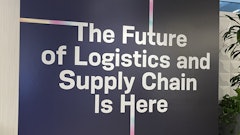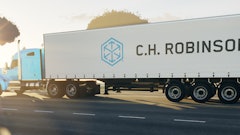
Smartphones are poised to take on a larger role in the route delivery world by becoming another choice for fleet managers who want to stay in touch with their drivers.
These phones, such as the Motorola MC35, are seen as a middle ground solution for fleets, taking up a position in the device world between the common cell phone and the rugged handheld mobile computer unit; both in terms of functionality and price.
Handhelds can run a fleet $3,000 per unit, while Smartphones range from $800 to $1,700 in price. And while this is nowhere as inexpensive as paying $60 for a low-end cell phone, most experts believe that smartphones will eventually drop in price.
In addition to being GPS enabled, smartphones are capable of running complete operating system software, such as Windows Mobile, which provides a standardized interface and platform for application developers. This is in contrast to the average mobile phone, which runs on Java software and provides little mobile computing power.
"Standard phones have about 780K of memory on them. Smartphones have at least four gigs of memory on them, which is what is required for robust computing power," says James Stevenson, vice president of Appian Logistics, an Oklahoma City, OK-based provider of mapping and vehicle routing software. Its clients predominately use its software solutions on cell phones.
"The smartphone is like a little computer. There is more processing power on this type of phone then there is on the rovers that NASA sent into space," says Cindi Brandt, manager for marketing for UPS Logistics, Baltimore, MD.
John Higgins, director of business solutions supporting transportation distribution, retail and manufacturing verticals for Sprint, Overland Park, KS, agrees. "Technology is jumping so quickly into the cell phones and what we're able to do with them, that they are indeed like mini-computers."
He suggests that if a company has a young workforce, this can work to its advantage. "Giving them a cell phone and teaching them how to use it from a technology perspective will be a fairly simple thing to do. They're already computer literate."
According to UPS' Brandt, another advantage is the fact that the GPS chips in smartphones are more accurate and allow for more precise geo coding as well as more precise location identification.
"They also allow for auto arrive and auto depart." Brandt says drivers don't have to manually input this information into their phones anymore when they arrive at a delivery site or leave it. The phone will do it automatically for them.
More Detailed Information
Additionally, typical GPS enabled cell phones can only provide basic GPS functions--turn by turn directions and the transmittal of positioning information back to a home office. Smartphones, thanks to the increasing number of applications being written for them, are able to provide a greater depth of GPS related information to end-users.
"We have a developers' program where we allow anyone who wants to write applications to our phone access to the application protocols so they can actually go in and write applications," notes Sprint's Higgins.
"A good example is a Windows mobile device that not only has GPS route information that allows a driver to get directions, but through our application partners like Sprint Navigation, can give a driver traffic updates in real time. If there's a major accident on his route, he can ask to be rerouted. These are the kind of solutions we can provide on our smartphones.
"It's more than just having GPS data about the location of a vehicle, it's about being able to take the GPS data and massaging it for use on the backend, not only for your internal business needs, but to satisfy your external customer needs," he adds.
As an example, Higgins' associates have created applications that take advantage of GPS data to inform warehousing operations when drivers are making return trips and--because the businesses have been integrated with such applications--they already know what's on the truck when it arrives. This allows them to unpack the product and cross-dock it for outward bound shipments much easier than before.
Another Windows-based application uses GPS to track a drivers' position and then, through the web, provide local fuel prices, weather information, where to get food and more. "All because the device knows where you are," says Higgins.
Another advantage that Smartphones also provide to users is the ability to transmit GPS data back to the home office through at least four different networks, including WWAN and WLAN.
"If I want to transmit GPS data, I'm going to have to be able to transmit it on someone's network," says Appian's Stevenson. "That's the way it works."
Having the availability of different network options provides least-cost routing options for getting data across networks. It also provides the security of having built-in redundancy should one of the networks go down.
"Whether the data is blue tooth, infrared or WIFI, we can take it and transmit it across the network so they can get real time information," says Sprint's Higgins.
Other Applications
Telogis is an Irvine, CA-based company that provides telematics, GPS, automatic vehicle location and location-based services and software. The company offers a software application called Ontrack Workforce which runs on higher end smartphones. Ontrack is an out-of-the-box application that addresses all the compliance pieces that are federally mandated for drivers to meet, such as hours of service reporting to the DOT.
The software also allows for the collection and dissemination of vehicle saftey inspections by drivers, via their smartphones, as they walk around the vehicle and check the brake lights and tire pressure.
"OnTrack also supports truck navigation solutions," says Newth Morris, president of Geobase at Telogis. "An example would be adding bridge height and weight restrictions that the driver can receive over his phone, as well as eliminating left hand turns for routes--any kind of fleet centric navigation type functions can be sent out to them in this fashion."
Telogis can also graft its software to look like the existing processes that a customer has, for example, creating electronic forms that look exactly like the paper forms a company uses. "As long as they have the device out there and it's powerful enough, it makes sense being able to have the ability to do electronic forms."
Morris also believes that the more companies can utilize smartphone technology to move process that were traditionally done by voice over to the mobile application side, the more organized they will become and the cheaper it will be to run their operations. Dispatching, for example, can be streamlined utilizing GPS and mobile applications.
"Say a job comes across the board in the dispatching office--a store needs a box of onions. The dispatcher can use the technology to find the closest driver and get a message to him to deliver a box to the store immediately, if he has the product onboard that is." In this way, customer satisfaction can also be increased.
So too can user satisfaction. One of Appian's customers has been having a major issue with latency on billing and resolving orders that have been shipped short or damaged. Stevenson says this threw the whole payment process into cycles where $2,000 payments were being held up for $50 worth of damaged items. The entire issue has been solved through the customer providing its drivers with smartphones that include a special invoicing application.
"They have the ability, by having an application running on a Windows enabled smartphone, to scroll through the purchase order, take an item off the invoice and re-adjust it. The customer signs it and then the back office can bill the invoice at the end of day."
There's no lengthy reconciliation process thanks to the application on the phone and Appian's customer has actually increased its cash flow process.
"Fortunately the hardware platform on today's smartphone has all of the pieces you need to put together a number of field service apps," says Telogis' Morris. "And now that the software is just beginning to catch up, we're starting to see the true capabilities of the devices."
This means more work can be pushed out to the driver while he's making deliveries, thereby eliminating paperwork for companies that cannot afford higher-end handheld units.
"You can also connect different devices to these phones, like a barcode scanner," says Appian's Stevenson. "There's a company called Baracoda that makes these little barcode scanners that work off of blue tooth."
Expanding Capabilities
Some scanners are already installed in the phones, which is the case with some of Motorola's high-end devices.
One of the advantages to these devices is that smartphones have enough memory installed in them to allow them to perform real-time checking against a manifest, at line item level detail, when a driver is scanning product.
"It's synching up in real time, which means that it can give you the confirmation that what you're scanning is right," says Appian's Stevenson. "Otherwise, you could scan all the items and when you go back to the truck and let it synch up with the hub, it would then tell you that you screwed up--after the fact."
The ability to do line item detail is a positive development for a smaller company that had previously been using a regular "dumb" cell phone in conjunction with paper invoicing. For example, a particular delivery stop might be due to receive two or more individual orders that were placed the previous day, at different times.
The first order had already been picked and wrapped by warehouse workers and therefore, when the second order was called in, it forced the creation of a second invoice. The next day, the driver would be arriving at the location with multiple paper invoices that could prove difficult to reconcile. The smartphone makes reconciling much easier.
"Each one of those line items, when you start breaking them down, is a lot of data to try and push out to a non-Windows mobile phone. Still the driver needs access to it electronically because he's out in the field trying to reconcile invoices with the customer," says Stevenson.
The other capability that a smartphone brings to the field is the ability to do customer signature capture, which was formerly something only the expensive handhelds could do. Companies such as Motorola have smartphones with touchscreen select capability, which allows a customer to sign the unit at the receiving dock, indicating that a delivery has been received.
Then, just like on a handheld, the information is sent back through a wireless network system to the company's order management system, which can then generate an invoice and thereby accelerate the billing cycle, as opposed to waiting for a piece of paper to come back to the office.



























